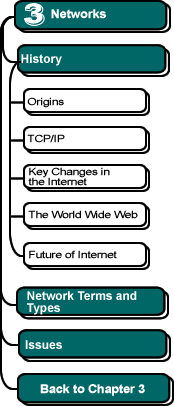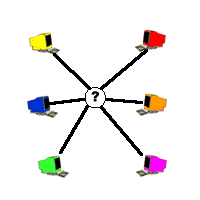

|
A Tower of Babel ?
The plan was to have the ARPANET serve as a backbone, a high-speed network into which other smaller, slower networks could connect. Thus, the ARPANET was to be an internetwork—a network made up of networks. In time the ARPANET came to referred to simply as the Internet.
After the successful connection between UCLA and Stanford, the ARPANET grew rapidly.
- By the end of
1969, computers at the research centers at the University
of California at Santa Barbara and the University of Utah had been added,
bringing the size of the ARPANET to four. The term
host was introduced to refer to any computer on the
ARPANET.

- By 1972,
there were 19 hosts.

- In 1973,
there were 25 hosts.

- In 1978,
there 111 hosts.

- By 1981, there were 223 hosts.
 This
growth of the ARPANET, however, also meant that the ARPANET had to contend
with a growing number of computer makes and models. Again, as we see today
with Macs and PCs, the hardware and software of the many different kinds
of computers on the ARPANET were not compatible. Each computer "spoke
a different language," if you will, and a kind of "Tower of
Babel" problem was beginning to occur.
This
growth of the ARPANET, however, also meant that the ARPANET had to contend
with a growing number of computer makes and models. Again, as we see today
with Macs and PCs, the hardware and software of the many different kinds
of computers on the ARPANET were not compatible. Each computer "spoke
a different language," if you will, and a kind of "Tower of
Babel" problem was beginning to occur.
The IMP computers handled the incompatibilities between computers, but it was becoming increasingly difficult to update their software to accomodate the new kinds of computers. In fact, at this rate, the ARPANET would soon be down for upgrades far too often.
A new solution was needed.
![]()
![]()
This chapter was written by Jeff Nyhoff and Joel Adams. Copy editing by
Nancy Zylstra
©2005 Calvin University (formerly Calvin College), All Rights Reserved
If you encounter technical errors, contact computing@calvin.edu.